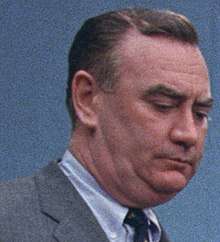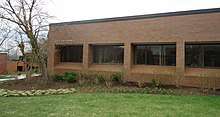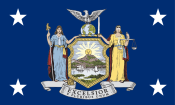Hugh Carey
Hugh Leo Carey (April 11, 1919 – August 7, 2011) was an American politician and attorney. He served as a seven-term United States Representative from 1961 to 1974 as well as the 51st Governor of New York from 1975 to 1982.
Hugh Carey | |
|---|---|
 Carey at the White House in 1968. | |
| 51st Governor of New York | |
| In office January 1, 1975 – December 31, 1982 | |
| Lieutenant | Mary Anne Krupsak Mario Cuomo |
| Preceded by | Malcolm Wilson |
| Succeeded by | Mario Cuomo |
| Member of the U.S. House of Representatives from New York | |
| In office January 3, 1961 – December 31, 1974 | |
| Preceded by | Francis E. Dorn |
| Succeeded by | Leo C. Zeferetti |
| Constituency | 12th district (1961–63) 15th district (1963–74) |
| Personal details | |
| Born | Hugh Leo Carey April 11, 1919 New York, New York, U.S. |
| Died | August 7, 2011 (aged 92) Shelter Island, New York, U.S. |
| Resting place | Our Lady of the Isle Cemetery Dering Harbor, New York, U.S. |
| Political party | Democratic |
| Spouse(s) | Helen Owen
( m. 1947; died 1974)Evangeline Gouletas
( m. 1981; div. 1989) |
| Children | 14, including Paul |
| Alma mater | St. John's University (BA, JD) |
| Profession | Lawyer |
| Military service | |
| Allegiance | |
| Branch/service | • New York Army National Guard |
| Years of service | 1939–1946 |
| Rank | |
| Unit | 101st Cavalry Regiment 415 Infantry Regiment 104th Infantry Division |
| Battles/wars | World War II • European Theatre |
| Awards | Croix de Guerre Bronze Star Medal |
Early life
Carey was born in New York, New York, the son of Margaret (Collins) and Dennis Joseph Carey.[2] He was in the U.S. Army during World War II, serving in Europe and reaching the rank of Major. He received his B.A. degree in 1942 and J.D. degree in 1951 from St. John's University and was admitted to the bar that same year.[3]
Military service
In 1939, Carey enlisted in the New York National Guard as a Private in C Squadron, 101st Cavalry. Later, he served as a Major in the 104th Infantry Division, known as the "Timberwolves." He served in the 415th Infantry Regiment of the 104th Division as the Regimental S-3, operations officer.[4] Carey was with the 104th Division throughout its 10-month campaign in the European Theater of Operations, which included the fighting in Northern France, Holland and Germany. His awards include the Combat Infantryman Badge, the Bronze Star with Oak Leaf Clusters, and the Croix de Guerre with Silver Star. Carey left the service after the war with the rank of Colonel.[5]
Early political career
Running as a Democrat, Carey was elected to the United States House of Representatives in 1960, unseating Republican incumbent Francis E. Dorn. He served seven terms, and was the first congressman to oppose the Vietnam War.[6]
In 1966 he was appointed Chairman of the Adhoc Subcommittee on the Handicapped by Adam Clayton Powell, then Chairman of the House Education and Labor Committee. The sub-committee held hearings in Washington and New York City and Carey introduced HR 14. The "Carey Bill" provided, for the first time, a program of grants to the states for "initiating, expanding or improving education for children with disabilities. It also included other titles mirroring the structure of the Elementary and Secondary Education Act, PL 89-10, which Carey had assisted Powell in passing as part of the Lyndon Baines Johnson initiative.
Three parts of the Bill were picked up by the Senate: the grants to states, a new Bureau of Education for the Handicapped in the U.S. Office of Education and a National Advisory Committee. Carey's friend and mentor, John Fogerty of Rhode Island, the powerful Chairman of the Appropriations Subcommittee which provided funding for all Health, Education and Welfare programs, backed his legislation. The bill became Title VI of the ESEA, as Public Law 89-750, in 1966. Carey also sponsored and saw passed that year The Model Secondary School for the Deaf Bill, to be established on the campus of the world's only liberal arts college for the deaf. In 1965, he and Fogerty had sponsored The National Technical Institute for the Deaf, which was awarded to the Rochester Institute of Technology.
The Carey Bill and its grant program to the states began with a $2.5 million appropriation, to provide each state with $50,000 to plan for its implementation. The second year, the appropriation was $12.25 million, distributed to the states in proportion to their population. In 1975 Congress passed the Education for All Handicapped Children Bill, PL 94-142 which today distributes approximately $11 billion to the states for this purpose.[7]
He served on the House Ways and Means Committee and led the effort to pass the first Federal Aid to Education program. He was elected Governor of New York in 1974 and resigned his Congressional seat on December 31, 1974. Carey was reelected in 1978, serving two full terms as governor. On January 1, 1983, he was succeeded by his lieutenant governor, Mario Cuomo. Carey then returned to private law practice with the firm of Harris Beach in New York City, where he resided until his death in August 2011.
Governorship
In the state election of 1974, Carey became New York's first Democratic governor in 16 years, unseating incumbent Republican Malcolm Wilson, who had assumed the office after Nelson Rockefeller resigned in December 1973 (to work on the Commission on Critical Choices for Americans). Nationally, the 1974 election was dominated by the Watergate scandal which had destroyed President Richard Nixon's presidency and hurt Republicans nationwide. In 1974, Democrats also recaptured the New York State Assembly.
Carey is best remembered for his successful handling of New York City's economic crisis in the mid-1970s. As governor he was responsible for building the Jacob K. Javits Convention Center; Battery Park City; the South Street Seaport and the economic development of the NYC boroughs outside Manhattan. He also helped provide state funding for the construction of the Carrier Dome at Syracuse University.[8] He is also remembered for preventing conservative legislators from reinstating the death penalty and preventing such legislators from taking away state abortion laws.
Upon taking office, Carey cut taxes significantly, reducing corporate taxes from 14% to 10%, and capping personal income tax at 9%, and reducing capital gains taxes as well. His administration also offered tax credits to encourage new investment.[9]

Carey came into office with New York City close to bankruptcy. He brought business and labor together to help save New York City from the fiscal crisis that befell it in the 1970s. Carey managed to keep the growth of state spending below the rate of inflation through his frequent use of line-item vetoes and fights with the New York State Legislature, which was at the time divided between a Republican-controlled Senate and a Democratic-controlled Assembly.[10]
Carey signed the Willowbrook Consent Decree,[11][12] which ended the warehousing of the mentally ill and developmentally disabled. His vision and leadership led to the community placement of the mentally ill and developmentally disabled. He also made major strides in community programs for the mentally ill.
Carey's tenure in office was marked by a growing awareness of the environmental consequences of New York's strong industrial base, including the designation by the federal government of the Love Canal disaster area. Carey made environmental issues a priority of his administration.
Along with Senators Edward Kennedy and Daniel Patrick Moynihan and U.S. House Speaker Tip O'Neill, Carey led efforts to end the violence in Northern Ireland and support peace in the region. The four Irish-American politicians called themselves "The Four Horsemen."[13]
Carey considered running for president in 1976 and 1980. Carey's first wife had died in 1974, and Carey later attributed his decision not to seek the Democratic nomination for president in 1976 to her death.
Carey pardoned Cleveland "Jomo" Davis, one of the leaders of the Attica prison riots.
In 1978, he was challenged for re-election by State Assembly Minority Leader and former Assembly Speaker Perry Duryea. After a competitive, sometimes negative campaign, Carey was the first Democrat re-elected in 40 years. Carey decided against seeking a third term as governor in 1982. Mario Cuomo succeeded him.
In 1989, Carey announced that he was no longer pro-choice and regretted his support for legalized abortion and public financing of abortion as governor. In 1992, he joined other pro-life leaders in signing the pro-life document "A New American Compact: Caring About Women, Caring for the Unborn."[14]
Carey was a partner in the law firm of Finley, Kumble, Wagner, Underberg, Manley, Myerson & Casey. Later in his life, he was of counsel at the law firm of Shea & Gould. He continued to practice law as a member of the Harris Beach law firm and sat on the board of Triarc Cos.,[15] the Nelson Peltz controlled holding company.
Family and death
In 1947, Carey married Helen Owen (1924–1974). The two had a very happy marriage, and they became the parents of Alexandria, Christopher, Susan, Peter, Hugh, Jr., Michael, Donald, Marianne, Nancy, Helen, Bryan, Paul, Kevin, and Thomas. His wife, Helen, died of breast cancer in 1974. Peter and Hugh, Jr. died in an automobile accident in 1969. Carey was devastated by the death of his wife and laid to rest any plans for the White House. Paul, who served as White House Special Assistant to President Bill Clinton as well as 77th Commissioner of the Securities and Exchange Commission, died of cancer in 2001.
In 1981, Carey married Evangeline Gouletas, a Chicago-based real estate mogul, just three months after meeting her.[16] This marriage proved controversial and a political liability. The marriage generated controversy due to false statements Gouletas made about her marital history. Initially, Gouletas claimed that she was a widow of a single marriage but later affirmed on the marriage license that she had two ex-husbands.[17] Gouletas also said that her first husband, with whom she had a daughter, was dead, but he was still alive at the time. In reality, she actually had three previous marriages, and all three of her former husbands were still living at the time. The marriage also caused trouble for Carey with the Catholic Church, since he married a thrice-divorced woman in a Greek Orthodox Church; the church, which does not recognize civil no-fault divorce, refused to perform communion. To an extent, the marriage also hurt his public reputation. Carey and Gouletas divorced in 1989.[18] Carey later described this marriage as "his greatest failure."[19]
Carey died surrounded by his family on August 7, 2011. He was at his summer home on Shelter Island, New York.[20]
Legacy

On October 22, 2009, he was named as the recipient of University at Albany Foundation's Citizen Laureate Award.[21] On October 22, 2012, the Brooklyn Battery Tunnel was officially renamed the "Hugh L. Carey Tunnel".[22] Building 14 at the Rochester Institute of Technology was named for Carey in 1984.[23]
References
- https://www.nytimes.com/2011/08/08/nyregion/hugh-carey-who-led-fiscal-rescue-of-new-york-city-dead-at-92.html
- "The Man Who Saved New York" Hugh Carey and the Great Fiscal Crisis of 1975".
- "Hugh Carey through the years: a 'True American success story'". Times Union. The Hearst Corporation. August 8, 2011. Retrieved October 3, 2016.
- Photo, New York State Archives, Hugh L. Carey and other members of the 415th Infantry Regiment Headquarters, http://digitalcollections.archives.nysed.gov/index.php/Detail/Object/Show/object_id/10077
- The U.S. Congressional Record, Volume 141, Number 187 (Monday, November 27, 1995), U.S. Senate, https://www.gpo.gov/fdsys/pkg/CREC-1995-11-27/html/CREC-1995-11-27-pt1-PgS17521-2.htm
- Tracy, Thomas (August 8, 2011). "Hugh Carey, governor who saved New York, is dead". The Brooklyn Paper. Retrieved October 3, 2016.
- Martin, Edwin W. (2013). Breakthrough: Federal Special Education Legislation, 1965–1981. New Chapter Publisher. ISBN 978-1938842054.
- Kirst, Sean (August 7, 2011). "Answering a question: Hugh built the dome?". syracuse.com. Retrieved May 30, 2020.
- http://search.proquest.com/docview/121886438
- Carroll, Thomas W. (Spring 1994). "The Status Cuomo". Policy Review. Retrieved August 8, 2011.
- "Willowbrook Class – OPWDD".
- "The Willowbrook Consent Decree". Archived from the original on April 30, 2016. Retrieved September 27, 2015.
- "The last horseman raises his hat — Irish Echo".
- "A New American Compact: Caring About Women, Caring for the Unborn". Catholic Online. June 17, 2008. Retrieved April 10, 2016.
- "Triarc". Triarc. Archived from the original on May 5, 2004. Retrieved August 8, 2011.
- Mills, Barbara Kleban (May 4, 1981). "New York's Gov. Hugh Carey Weds the Empress of Mondo Condo, a Not-So-Sweet Evangeline". People. Retrieved August 8, 2011.
- "Evangeline Gouletas Carey, who once claimed she was the..." UPI. Retrieved September 13, 2018.
- Walls, Jennifer (July 31, 1989). "New York Intelligencer: Hugh and Engie: Split Ends". New York. Retrieved August 8, 2011.
- Roberts, Sam (December 5, 2005). "Requiem for a (Still-Living) Heavyweight". The New York Times.
- "Former Governor Hugh Carey Dead At 92". NY1. August 7, 2011. Archived from the original on January 30, 2013. Retrieved August 7, 2011.
- "Hugh Carey Named UAlbany Citizen Laureate – University at Albany-SUNY".
- "Brooklyn-Battery Tunnel Renamed After Late Gov. Hugh Carey". cbslocal.com. CBS Local Media. October 22, 2012. Retrieved October 3, 2016.
- AVALLONE, ILENE J. "The changing campus landscape – NTID 50th Anniversary". www.rit.edu. Retrieved May 30, 2020.
- United States Congress. "Hugh Carey (id: C000143)". Biographical Directory of the United States Congress.
Bibliography
- Kramer, Daniel C. (1997). The Days of Wine and Roses are Over: Governor Hugh Carey and New York State. University Press of America. ISBN 9780761805625.
- Lachman, Seymour P.; Polner, Robert (2010). The Man Who Saved New York: Hugh Carey and the Great Fiscal Crisis of 1975. Albany: SUNY Press.
Primary sources
- Almeida, Linda Dowling, Peter Quinn, and Hugh Carey. "Oral History: Governor Hugh Carey Interviewed by Peter Quinn." American Journal of Irish Studies (2012): 179–190. in JSTOR
External links
| Wikimedia Commons has media related to Hugh Carey. |
- United States Congress. "Hugh Carey (id: C000143)". Biographical Directory of the United States Congress.
- Appearances on C-SPAN
- Hugh Carey on Charlie Rose
- Hugh Carey on IMDb
- "New York's Forgotten Governor" through the University at Albany, SUNY.
- Works by or about Hugh Carey in libraries (WorldCat catalog)
- "Hugh Carey collected news and commentary". The New York Times.
| U.S. House of Representatives | ||
|---|---|---|
| Preceded by Francis E. Dorn |
Member of the U.S. House of Representatives from New York's 12th congressional district 1961–1963 |
Succeeded by Edna F. Kelly |
| Preceded by John H. Ray |
Member of the U.S. House of Representatives from New York's 15th congressional district 1963–1974 |
Succeeded by Leo C. Zeferetti |
| Political offices | ||
| Preceded by Malcolm Wilson |
Governor of New York 1975–1982 |
Succeeded by Mario Cuomo |
| Party political offices | ||
| Preceded by Arthur Goldberg |
Democratic nominee for Governor of New York 1974, 1978 |
Succeeded by Mario Cuomo |
